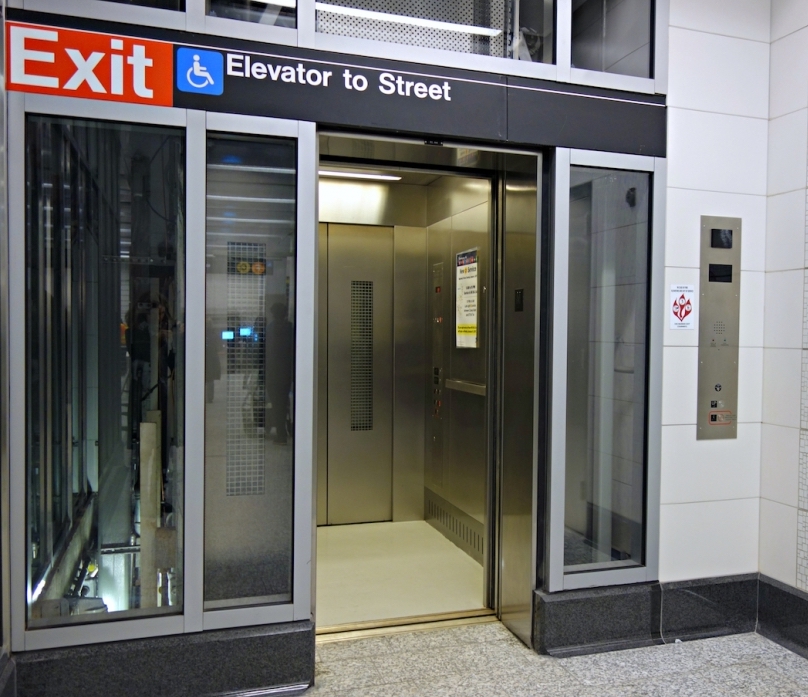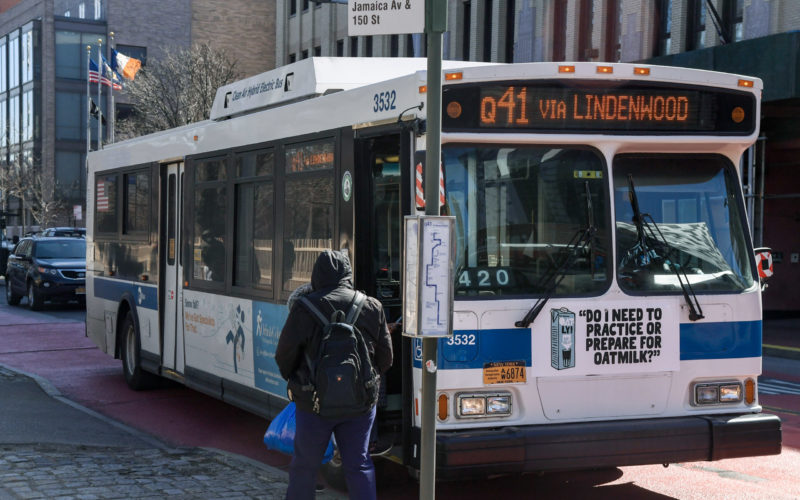
New York City’s MTA blames many of its problems on aging infrastructure. But now it’s also blaming some of them on new infrastructure. One of the NYC subway’s worst performing elevators is in fact less than a year old. An elevator at the Lexington Ave-63rd St station installed as part of the Second Avenue Subway project was usable by the public only 81% of the time over the first nine months of 2017. Unfortunately, the apparent conundrum is emblematic of chronic lousy performance by the MTA’s elevator and escalator division. That department should be completely overhauled, along with the MTA’s bad, begrudging attitude about subway station accessibility.
The availability of the Lex/63rd elevator in question (known as EL443) during the first quarter of 2017 was particularly abysmal — a mere 64%. (The MTA uses the term “availability” — also referred to as “uptime” — to mean the amount of time an elevator is working and available to riders.) Out of a total of 244 elevators (spread across 109 stations), this brand new elevator ranked the worst in the first quarter of 2017.
It would be unacceptable if a new car or cell phone worked only 64% of the time in the first three months of use. For that matter, if a newly installed elevator in the new World Trade Center building failed that often, management would fire its supplier and maintainer and find someone who could get the job done. But in a city that runs on elevators, the MTA still can’t get it done.
The MTA told amNY that it’s normal for new elevators to have problems. That might explain EL443’s disastrous first quarter, but not its bad record of outages for the rest of the year.
EL443’s performance improved in the second quarter, reaching 93% availability, but then dipped back down to 87% in the third quarter. While these numbers may sound like decent scores, what they add up to in annual terms is a new elevator out of service the equivalent of nearly 69 days, or for nearly 5 hours every day. The terrible culture regarding accessibility within the MTA simply doesn’t acknowledge the desperate straits the lack of elevators can cause for someone who cannot use stairs to use the subway system.
EL443’s uptime falls well below the MTA’s target elevator availability of 96.5% — an already anemic target when compared with that of other old U.S. subway systems. What 96.5% amounts to is a guarantee of more than two weeks of downtime per elevator per year, or about an hour a day – per elevator. For those who need elevators for subway access, that’s like the A Train simply being out of service for two weeks.
Boston and Chicago, on the other hand, are both able to regularly maintain a minimum of 99% availability across their entire systems. NYC should be able to do the same, or better.
MTA excuses about “breaking in” a new elevator would have more credence if EL443 was an isolated case. But nothing about its bad performance is new. An audit of MTA elevator maintenance released by the NYC Comptroller this past spring found:
- The MTA didn’t perform 80% of preventive maintenance work on schedule
- A third of scheduled inspections and repairs were either not performed at all, or were performed way off schedule
- Of preventive maintenance work that was performed, only 25% of required checklists were completed by MTA workers
- MTA maintenance crews created work orders for only 25% of new defects discovered during preventive maintenance
- The MTA has no formal system for tracking repair of defects when work orders are created.
Sadly, the 2017 audit is the only the most recent in a growing canon of investigations into the MTA’s elevator problems. This collection of reports, going back to 2000, indicates that the MTA has made few efforts to improve elevators and escalators, or to take accessibility seriously.
- In 2000, Mark Green, NYC Public Advocate detailed the MTA’s elevator and escalator performance failures between 1994 and 2000, finding that the average subway station elevator was out of service an average of 26 days a year, and that 74% of downtime was due to broken equipment.
- In 2004, NY State Comptroller Alan Hevesi audited MTA accessibility for people with disabilities. It found the agency “does little to monitor the way the subway system is being used by people with disabilities…. Making the stations ADA compliant does not necessarily mean that the needs of individuals with disabilities are being met.”
- A 2008 NY Times investigation revealed that: “One of every six elevators and escalators in the subway system was out of service for more than a month last year,” and “Two-thirds of the subway elevators — many of which travel all of 15 feet — had at least one breakdown last year in which passengers were trapped inside.” The Times attributed this high outage rate to the MTA’s low training standards for maintenance workers. The Timesfound that workers “often rush[ed] balky elevators and escalators back into service without identifying the underlying causes of mechanical problems, leading to more breakdowns.”
The overall performance of the MTA’s subway elevators in the first three quarters of 2017 fell below the MTA’s weak performance target, with 24-hour subway elevator availability at an average of 95.8%. The poor performance of brand-new subway elevators means the agency can no longer hide behind the excuse of aging infrastructure. In order to fix its elevator problems, the MTA must fix its broken culture first.
H/T (or apologies?) to Ben Kabak re our title
 Built to Win: Riders Alliance Campaign Secures Funding for More Frequent Subway Service
Built to Win: Riders Alliance Campaign Secures Funding for More Frequent Subway Service
Thanks to Riders' Alliance successful #6MinuteService campaign, New York City subway riders will enjoy more frequent service on nights and weekends, starting this summer. In this post, we chronicle the group's winning strategies and tactics.
Read More How Much Service did the Largest Transit Agencies Run in 2021?
How Much Service did the Largest Transit Agencies Run in 2021?
In this post, we’re drilling down into 2021 service levels across mode in the seven highest ridership cities to see the choices agencies are making about how to allocate service, as well as to gauge the impact operator shortages are having.
Read More